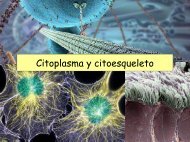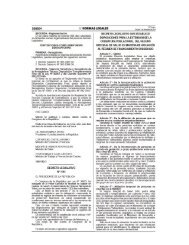Anticoagulacion
Create successful ePaper yourself
Turn your PDF publications into a flip-book with our unique Google optimized e-Paper software.
40<br />
Anticoagulación en válvulas cardíacas<br />
Los pacientes que posean un coágulo grande que obstruye<br />
la válvula y se encuentren en clase funcional III ó IV<br />
de la NYHA, deben someterse a cirugía de inmediato. La<br />
terapia trombolítica se reserva para pacientes con alto riesgo<br />
quirúrgico o en quienes la cirugía esté contraindicada.<br />
La Estreptokinasa y la Urokinasa son los agentes<br />
trombolíticos más usados. La duración del tratamiento<br />
trombolítico depende de la mejoría de los gradientes<br />
transvalvulares y de la recuperación del área valvular efectiva,<br />
medidas por ecografía Doppler. Ésta debe suspenderse<br />
luego de 24 horas si no hay mejoría hemodinámica o<br />
máximo 72 horas después si la recuperación hemodinámica<br />
no es completa (22). Si la terapia trombolítica tiene<br />
éxito debe continuarse un goteo de heparina intravenosa<br />
hasta que los niveles de warfarina alcancen un INR de 3 a<br />
4 para los aórticos y de 3,5 a 4,5 para las prótesis mitrales.<br />
Los pacientes con un «coágulo pequeño» en clase<br />
funcional I-II de la NYHA y aquellos con disfunción ventricular<br />
izquierda, deben hospitalizarse y recibir goteo continuo<br />
de heparina IV; si no se logra mejorar la imagen o se<br />
compromete la función cardíaca deben recibir un tratamiento<br />
trombolítico por varios días, y si a pesar de la terapia<br />
trombolítica no hay respuesta o deterioro se debe reoperar.<br />
En casos exitosos se puede convertir la infusión de<br />
heparina por heparina subcutánea 2/día manteniendo el<br />
PTT entre 55 y 80 segundos, e iniciar warfarina hasta obtener<br />
un INR de 2,5 a 3,5 por 1 a 3 meses en forma<br />
ambulatoria, para lograr un efecto trombolítico completo,<br />
luego de lo cual se mantendrá el INR con warfarina como<br />
única terapia entre 3 y 4 para los pacientes aórticos y entre<br />
3,5 y 4,5 para los mitrales, quienes deben recibir<br />
adicionalmente ácido acetil-salicílico a dosis bajas.<br />
Bibliografía<br />
1. Rowe JC, Bland EF, Sprague HB. The course of mitral<br />
stenosis without surgery: ten and twenty year perspectives.<br />
Ann Intern Med 1960; 52: 741-749.<br />
2. Coulshed N, Epstein EJ, McKendrick CS, Galloway RW,<br />
Walker E. Systemic embolism in mitral valve disease. Br<br />
Heart J 1970; 32: 26-34.<br />
3. Caplan LR, D’Cruz I, Hier DB, Reddy H, Shah S. Atrial size,<br />
atrial fibrillation, and stroke. Ann Neurol 1986; 19: 158-161.<br />
4. Stroke Prevention in Atrial Fibrillation Investigators. Predictors<br />
of thromboembolism in atrial fibrillation, I: clinical features<br />
of patients at risk. Ann Intern Med 1992; 116: 1-5.<br />
5. Stroke Prevention in Atrial Fibrillation Investigators. Predictors of<br />
thromboembolism in atrial fibrillation, II: echocardiogra-phic<br />
features of patients at risk. Ann Intern Med 1992; 116: 6-12.<br />
6. 168. Yoshida M, Nakamura Y, Higashikawa M, Kinoshita M.<br />
Predictors of ischemic stroke in non-rheumatic atrial<br />
fibrillation. Int J Cardiol 1996; 56: 61-70.<br />
7. Stollberger C, Chnupa P, Kronik G, Brainin M, Finsterer J,<br />
Schneider B, Slany J. Transesophageal echocardiography<br />
to assess embolic risk in patients with atrial fibrillation. Ann<br />
Intern Med 1998; 128: 630-8.<br />
8. EAFT (European Atrial Fibrillation Trial) Study Group. Secondary<br />
prevention in non-rheumatic atrial fibrillation after transient<br />
ischaemic attack or minor stroke. Lancet 1993; 342: 1255-62.<br />
9. Yoshida M, Nakamura Y, Higashikawa M, Kinoshita M. Predictors<br />
of ischemic stroke in non-rheumatic atrial fibrillation. Int J<br />
Cardiol 1996; 56: 61-70.<br />
10. Rockson Stanley G, Albers Gregory W. Comparing the<br />
guidelines: anticoagulation therapy to optimize stroke<br />
prevention in patients with atrial fibrillation. J Am Coll<br />
Cardiol. 2004; 43 (6): 929-35.<br />
11. Levine HJ, Pauker SG, Eckman MH. Antithrombotic therapy<br />
in valvular heart disease. Chest 1995; 108: 360S-370S.<br />
12. Bonow et al. ACC/AHA task force report. JACC 1998; 32<br />
(5): 1486-1582.<br />
13. Mc Bride R. Stroke prevention in atrial fibrillation<br />
investigators. Adjusted dose warfarin vs. low-intensity fixed<br />
dose warfarin plus aspirin for high risk patients with atrial<br />
fibrillation: stroke prevention in atrial fibrillation III randomized<br />
clinical trial. Lancet 1996; 348-633.<br />
14. Hirsh J, Hoak J. Management of deep venous thrombosis<br />
and pulmonary embolism. Circulation 1996; 93: 2212-2245.<br />
15. Simioni P, Prandoni P, Lensing AWA, et al. The risk of recurrent<br />
venous thromboembolism in patients with an Arg 506 —Gln<br />
mutation in the gene for factor V (factor V Leiden). N Engl<br />
J Med 1997; 336: 399-403.<br />
16. Koniaris LS, Goldhaber SZ. Anticoagulation in dilated<br />
cardiomyopathy. J Am Coll Cardiol 1998; 31: 745-748.<br />
17. Vongpatanasin W, Hillis LD, Lange RA. Prosthetic heart<br />
valves. N Engl J Med 1996; 335: 407-416.<br />
18. McAnulty JH, Rahimtoola SH. Antithrombotic therapy in<br />
valvular heart disease. In: Schlant R, Alexander RW, eds.<br />
Hurst’s The Heart, Arteries, and Veins. 9 th ed. New York, NY:<br />
McGraw-Hill Publishing Co; 1998. p. 1867-1874.<br />
19. Heras M, Chesebro JH, Fuster V, et al. High risk of<br />
thromboembolism early after bioprosthetic cardiac valve<br />
replacement. J Am Coll Cardiol 1995; 25: 1111-1119.<br />
20. Turpie AG. Antithrombotic therapy after heart valve<br />
replacement. In: Yusuf S, Cairns J, Camm J, Fallen E,<br />
Gersh B, eds. Evidence Based Cardiology. London, UK:<br />
BMJ Publishing Groups; 1998. p. 905-911.<br />
21. Ginsberg JS, Hirsh J. Use of antithrombotic agents during<br />
pregnancy. Chest 1995; 108: 305S-311S.<br />
22. Al-Khadra AS, Salem DN, Rand WM, Udelson JE, Smith JJ,<br />
Konstam MA. Warfarin anticoagulation and survival: a cohort<br />
analysis from the Studies of Left Ventricular Dysfunction.<br />
J Am Coll Cardiol 1998; 31: 749-753.<br />
23. Lengyel M, Fuster V, Keltai M, et al. Guidelines for management<br />
of left-sided prosthetic valve thrombosis: a role for<br />
thrombolytic therapy: Consensus Conference on Prosthetic<br />
Valve Thrombosis. J Am Coll Cardiol 1997; 30: 1521-1526.<br />
24. Hurrell DG, Schaff HV, Tajik AJ. Thrombolytic therapy for<br />
obstruction of mechanical prosthetic valves. Mayo Clin<br />
Proc 1996; 71: 605-613.<br />
http://booksmedicos.blogspot.com





